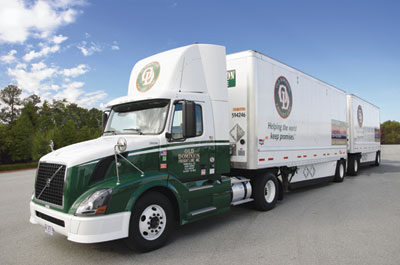LTL leader poised for more growth, profits, ODFL CEO Congdon discloses
Old Dominion Freight Line, which a generation ago made a company-changing decision to embark on a diversification growth path away from its roots as merely a Southeast regional LTL carrier, is now poised for even more profitable growth as a national trucking leader.
Old Dominion Freight Line, which a generation ago made a company-changing decision to embark on a diversification growth path away from its roots as merely a Southeast regional LTL carrier, is now poised for even more profitable growth as a national trucking leader.
“We are poised with capacity to take on growth as the economy grows,” ODFL Vice Chairman and CEO David S. Congdon told LM. “Shippers put value on service than price. It’s cyclical. As economy gets stronger, shippers place service as a higher priority. When the economy is negative, they start to put more emphasis on price.”
Either way, ODFL seems to win. Last year, it posted an LTL industry-leading $295 million in net income on $2.99 billion revenue. That produced an eye-popping 83.8 operating ratio. The only thing more surprising was 2016 was sort of a down year for ODFL. In 2015, its OR was 83.2.
Now, as it hones its single-system linehaul network of regional, interregional, long-haul and crossborder system, ODFL is preparing for its 75th anniversary in two years with an ambitious schedule of expansion.
Currently, ODFL operates more than 8,000 tractors and 32,000 trailers from a system of 227 networks. But Congdon disclosed to LM plans to add perhaps as many as 35 more terminals in fast-growing metro areas such as Seattle, Atlanta, New York City, Houston, Chicago and elsewhere.
“We have approximately 35 more locations on our list for the future as identified by our regional vice presidents,” Congdon said. “In some areas we now have long pedal runs (to terminals). Perhaps we can open up an outlying market with a small service center to penetrate more outbound freight.”
Specifically, Congdon says ODFL has identified two facilities near Seattle for possible expansion. “Seattle has so much population and traffic. When you send out a pickup and delivery truck and they’re jammed up for hours in traffic, that windshield time costs a lot of money.”
If ODFL was so inclined, Congdon said, it could open “30 to 40” service centers if it merely wanted to win market share. But ODFL’s game plan has always been striving for profitable growth, not just growth for growth’s sake (even though it has grown to be No. 3 on LM’s LTL listing by revenue after FedEx Freight and XPO Logistics).
“We are putting emphasis on North American markets to become known as premier North American LTL company,” Congdon said.
He said the push to add up to three dozen more terminals probably would be completed in the next three to five years. “We feel our way along,” he said.
Whenever rival LTL carriers go out of business or downsize, industry insiders say ODFL is always among the first to pounce on strategically located terminals. It was the largest buying of terminals when Consolidated Freightways suddenly closed on Labor Day 2003. When YRC and FedEx Freight downsized during the recession, ODFL had the financial clout to buy some of their discarded terminals.
“If it comes on market and has extra land, we will pounce on real estate opportunities as they arise,” Congdon told LM. “In this day and age, 20-doors is not big enough for us. We need 60 or 80.”
LTL officials talk privately of the regulatory nightmare that building a new trucking terminal is. Between neighborhoods that don’t want heavy trucks rumbling through their streets and excessive environmental regulations, the Not-In-My-Backyard (NIMBY) crowd intimidates even hardened trucking executives.
“Between the regulatory agencies and NIMBYs, buying land and building a trucking terminals can be a 3-to-4 year process,” Congdon disclosed.
As for current business levels, Congdon called them “decent.” He is optimistic that the Institute for Supply Management (ISM) has hit 54. (Anything over 50 is generally good for freight carriers).
“I feel relatively optimistic about this year,” he said. “I know economic forecasts are for GDP growth in the range of 2.1-to-2.2 percent,” he said. “That’s better than 1.6 that we had been getting.”
Congdon says it’s still too early to see a “Trump Effect” from the new team in Washington. “I believe he will get things done,” he said. “But politics are tougher than just talk.”













